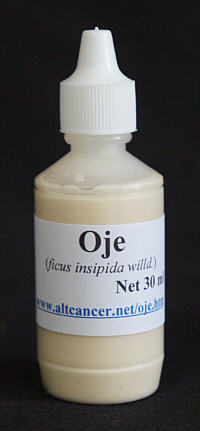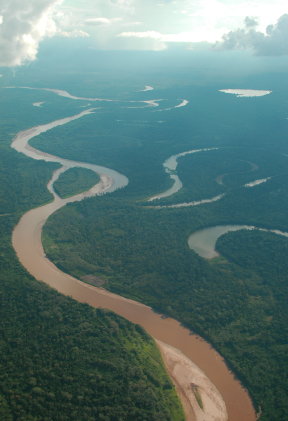|
Vermifuge / Vermicidal / Antihelmintic
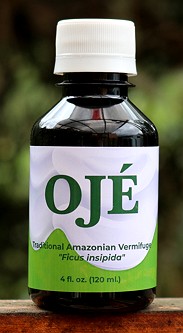
Oje (Resin)
[ Tree resin of Ficus insipida (Wildl.) ]
Code 392 -- Price: $4.95
Net : One Fluid Ounce (30 ml.)
Code 392B -- Price: $18.75
Net: Four Fluid Ounces (120 ml.)
Order Now
 Email
Email
 Summarized Description: Summarized Description:
Oje is one of the most important "medicines" used by the indigenous
in the Amazon, because the area is unquestionably the most
parasite-infested region in the world. If parasites are a concern
to village people in the Peruvian Amazon, they can take papaya
and/or zapallo seeds, along with various concoctions incorporating
paico to get rid of the
problem if it isn't severe.
 Oje is what you take
when the problem is severe.
 The tree itself is majestic,
but its humble beginnings intimate what it will eventually become :
it starts as a climbing vine that clings to another mature tree,
strangling it with time. Essentially, Oje -- when young -- makes
its way to adulthood by being a parasite, only to provide one of
the world's most potent deworming medications when it reaches
adulthood.
 A member of the the Fig family,
Oje is used for a wide variety of ailments, but none as
vital, needful, or as frequent, as its use as a
parasite killer.
Uses & Protocols
 This product is a concentrated resin
and the recommended dosage should not under any circumstances be
exceeded..
 Local residents in Pucallpa
take one Tablespoon for two to three days, depending on the degree
of infestation. (The 30 ml. bottle we sell is sufficient
for two days, or two dosages.) This one tablespoon (15 ml.) is
mixed with the freshly-squeezed orange juice from two to three oranges.
More serious parasite issues call for taking this one tablespoon
in orange juice for seven days (which would mean you would
need four bottles to ensure taking a complete "course").
 Dietary Recommendations: Dietary Recommendations:
- Avoid greasy or salty foods for one week.
- No exposure to direct sunlight for one week.
- For best results, take at night -- without food.
If you do need to eat, wait 45 minutes after taking the product
before eating a light meal.
- Lastly, and perhaps more of cultural interest than anything else,
shamans advise "avoiding being seen by strangers to the family."
(This turns out to be more practical than superstitious.
After all, who wants to be greeted by strangers when they may
be dealing with gastrointestinal issues for the two or three
days they are "under the influence" of Oje?)
Warnings & Contraindications
 As we stated previously, take the Oje
precisely as indicated. Although not technically an abortifacient, do
not use internally if attempting to conceive, are pregnant, or are lactating.
No child under the age of 12 should consume this product.
Duke notes the dangers of excess use ( 1 ) :
 "Latex caustic to the eye; dry latex
oculo- and dermo-irritant; 10-15% solution has killed experimental cats,
guinea pigs, and rats within 24 hours (JFM). Most of the 39 reported
toxic reactions over a 12-year period near Pucallpa were probably due to
overdose, defined as more than 1.5 cm(3)/kg, the recommended dose being
1 cm.(3)/kg. [Editor's Note: This is not the dosage for the concentrated resin].
In five cases toxic reactions occurred at the lower doses but were viewed
as idiosyncratic reactions. All were children, and in two cases was
severe reaction. Three fatal outcomes were observed in the 12-year
period (estimated mortality 0.01-0.015%). Severe cases experienced
cerebral edema. Treatment was osmotic diuresis with mannitol (started in 1996)
(X15814256). Though traditionally used in Central and South America as a
vermifuge, its use is not recommended due to high acute toxicity with
hemorrhagic enteritis in addition to it being only slightly anthelmintic
(X10363841). [Editor's Note: Our doctor / associate in Pucallpa
indicates that local people swear by Oje. They say it works when nothing
else will; although, as we state elsewhere, Paico
is generally used first before resorting to Oje. If Paico doesn't work,
then Oje is the "last resort."] As of July, 2007, the FDA Poisonous
Plant Database listed one title alluding to toxicity of this species. "Latex caustic to the eye; dry latex
oculo- and dermo-irritant; 10-15% solution has killed experimental cats,
guinea pigs, and rats within 24 hours (JFM). Most of the 39 reported
toxic reactions over a 12-year period near Pucallpa were probably due to
overdose, defined as more than 1.5 cm(3)/kg, the recommended dose being
1 cm.(3)/kg. [Editor's Note: This is not the dosage for the concentrated resin].
In five cases toxic reactions occurred at the lower doses but were viewed
as idiosyncratic reactions. All were children, and in two cases was
severe reaction. Three fatal outcomes were observed in the 12-year
period (estimated mortality 0.01-0.015%). Severe cases experienced
cerebral edema. Treatment was osmotic diuresis with mannitol (started in 1996)
(X15814256). Though traditionally used in Central and South America as a
vermifuge, its use is not recommended due to high acute toxicity with
hemorrhagic enteritis in addition to it being only slightly anthelmintic
(X10363841). [Editor's Note: Our doctor / associate in Pucallpa
indicates that local people swear by Oje. They say it works when nothing
else will; although, as we state elsewhere, Paico
is generally used first before resorting to Oje. If Paico doesn't work,
then Oje is the "last resort."] As of July, 2007, the FDA Poisonous
Plant Database listed one title alluding to toxicity of this species.
Shelf-Life
 Five years or more.
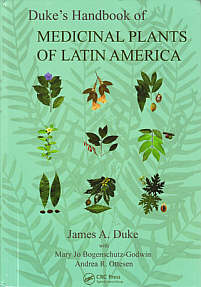
Medicinal Activities
 Further information for practitioners: Further information for practitioners:
World-famous botanist Dr. James Duke attributes the following activities
to this plant (p. 320-322; see hardcopy cover at right),
drawn from the extant literature. (See his graduation for "level of
efficacy" on our amazon traditionals page;
followed by Duke's bibliographic abbreviations (in capital letters),
which we identify
on a separate page.)
- Antiinflammatory (f; DAV);
- Antiseptic (f1; DLZ; 60P);
- Antitumor (f1; 60P);
- Aphrodisiac (f; SAR);
- Artemicide (1; 60P);
- Caustic (f; RAR);
- Cicatrizant (f; DLZ);
- Laxative (f; 60P);
- Memorigenic (f; RAR; SAR);
- Parasiticide (f1; 60P);
- Proteolytic (1; 60P);
- Purgative (f; RAR);
- Stimulant (f; RAR);
- Tonic (f; MD2, RAR);
- Toxic (1; X10363841; X15814256);
- Vermifuge (f; MD2; RAR).
Indications
 Further information for practitioners: Further information for practitioners:
Duke provides the following indications for this plant:
- Alzheimer's (f; RAR; SAR);
- Ancylostomiasis (f; MPB);
- Anemia (f; SOU);
- Anorexia (f; SOU);
- Cancer (f1; 60P);
- Cheilosis (f; DLZ);
- Constipation (f; 60P);
- Dyspepsia (f; IED);
- Enterosis (f; CTD);
- Fever (f; SOU);
- Fracture (f; DLZ);
- Gastrosis (f; DLZ);
- Impotence (f; SAR);
- Infection (f1; DLZ; 60P);
- Inflammation (f; DAV);
- Jaundice (f; MPB);
- Malaria (f; DLZ; JFM);
- Memory (f; RAR; SAR);
- Pain (f; IED);
- Parasites (f1; CTD; 60P);
- Rheumatism (f; CTD; DAV);
- Snake Bite (f; MD2);
- Sores (f; DLZ);
- Stings (stingray) (f; MD2; 60P);
- Stomachache (f; IED);
- Stomatosis (f; DLZ);
- Ulcers (f; DLZ);
- Worms (f; RAR);
- Wounds (f; DLZ).
Footnotes
- Duke, James A., ibid., p. 322.
|
 To U.S. Users: To U.S. Users: This product
have not been evaluated by the U.S. Food & Drug Administration.
It is not intended to diagnose, treat, cure, or prevent any disease.
|
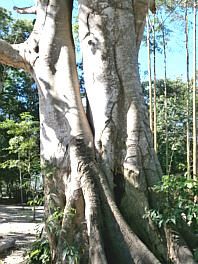
 Two stately specimens of
Oje taken in Pucallpa, Peru.
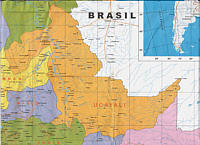 Sourcing From
Sourcing From
The Peruvian
Amazon
 All the materials used to
make our Oje are wild-crafted from sources in
the Ucayali Region of Peru.
Dosages &
Ethnobotanical
Usage
 Duke, quite predictably,
provides a "food farmacy potential" score for this plant of, "FNFF=!" ("Survival
food or little known but locally important; not in U.S. supermarkets.")
Fruit edible (DLZ, IED).
- Bolivia: Apply latex to sores of the lip and mouth; to wounds as antiseptic
and cicatrizant; to take root decoction for gastric ulcers (DLZ).
- Peru: Among the Madre de Dios Peruvians, they use the latex as a vermifuge (MD2),
like most ethnic groups from Bolivia to Central America. In broader numbers of ethnic groups
in Peru, the latex of Oje is used to treat stingray stings and snake bites (MD2).
- Nicaragua: The Garifuna apply the sap infusion or poultice orally or topically
for aches, pains, and dyspepsia (IED).
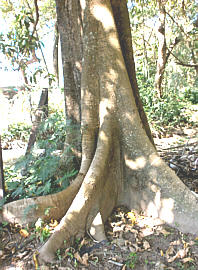
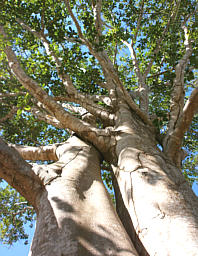
|


 A member of the the Fig family,
Oje is used for a wide variety of ailments, but none as
vital, needful, or as frequent, as its use as a
parasite killer.
A member of the the Fig family,
Oje is used for a wide variety of ailments, but none as
vital, needful, or as frequent, as its use as a
parasite killer.


